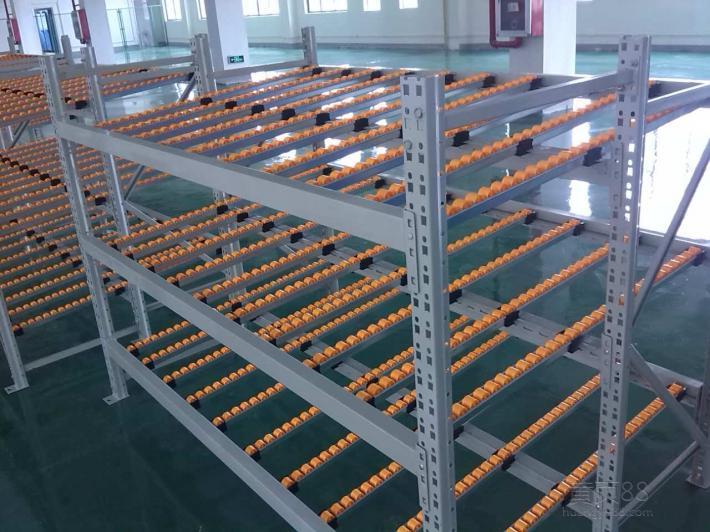Alright, let's talk warehouse efficiency. If you're drowning in slow picking times, constant reorganizing, or struggling to maximize every square foot, Flow Racking might just be your game-changer. This gravity-fed workhorse is famous for speeding things up and enforcing solid FIFO (First-In, First-Out) inventory control. But here’s the kicker: not all Flow Racking is created equal. Picking the wrong setup for your specific space and needs? That’s a recipe for wasted cash and ongoing headaches. So, let’s break down exactly how to choose the best Flow Racking for your unique operation. No fluff, just the practical stuff you need to know.
Step 1: Get Real About Your Space & Layout (Measure Twice, Order Once!)
Before you even think about specific Flow Racking models, grab your tape measure and a layout sketch. This is foundational.
- Ceiling Height is King: Seriously, look up! How much vertical space do you actually have? Don't forget clearances for sprinklers, lights, HVAC ducts, and any overhead conveyors. Taller ceilings let you stack more levels of Flow Racking, dramatically boosting storage density without expanding your building footprint. Measure from the finished floor to the absolute lowest overhead obstruction.
- Floor Plan Footprint: How much floor area can you dedicate to the Flow Racking system? Map it out precisely. Consider aisle widths – you need enough room for forklifts or pallet jacks to maneuver safely and efficiently, especially when feeding the lanes. Remember, Flow Racking typically requires access at both ends (loading and picking), so factor in that flow pattern.
- Column Conundrums: Those darn support columns! Note their exact locations and dimensions. Flow Racking systems need to be designed around these obstacles. Poorly placed columns can kill your layout efficiency or force awkward lane configurations.
- Doorways & Traffic Flow: Where are your receiving and shipping doors? How do people and equipment move through the space? Your Flow Racking needs to fit into this natural workflow, not create bottlenecks. You don't want your super-fast picking lanes causing a traffic jam at the dock.

Step 2: Know Your Inventory Inside and Out (What’s Actually Going on Those Lanes?)
Flow Racking isn't magic. Its effectiveness hinges entirely on what you're storing in it. Get granular with your inventory analysis.
- Pallet Size & Weight – Non-Negotiables: What are the exact dimensions (length, width, height) of the pallets you use? Measure them yourself; don't assume "standard." What's the maximum loaded weight per pallet? This is absolutely critical for determining the required structural strength of the Flow Racking beams, rollers/wheels, and frames. Underspec here, and you risk catastrophic failure.
- SKU Velocity is Your Compass: How fast does each product move? Flow Racking shines brightest for medium-to-high turnover SKUs. Identify your "A" movers – these are prime candidates. Putting slow-movers in expensive Flow Racking is usually a waste of capital and space. Group similar velocity items together.
- Consistency Matters: Flow Racking works best with uniform pallet loads. If you have wildly different pallet sizes or unstable loads, you'll face jams and uneven rolling. Assess your pallet build quality and consistency realistically.
- FIFO Isn't Always Mandatory: While Flow Racking is inherently FIFO, confirm you need FIFO for the products going into it. If FEFO (First-Expired, First-Out) or LIFO (Last-In, First-Out) is acceptable for some items, other racking types might be more suitable for those.
Step 3: Choosing Your Flow Racking Type & Components (The Nitty-Gritty)
Now we get into the heart of the system. Understand the options and their trade-offs.
- Roller vs. Wheel Decoder Rings: This is a fundamental choice.Roller Systems: Use gravity rollers (like a heavy-duty conveyor). Best for very smooth-bottomed pallets (think CHEP, GMA style), heavier loads, and slightly steeper declines. Generally offer smoother flow but can be pricier.Wheel Systems: Use skate wheels. More forgiving of slightly rougher pallet bottoms, often more cost-effective, and generate less noise. Ideal for medium-weight loads and standard pallets. Choose wheels with robust bearings!
- Lane Depth & Decline Angle: How many pallets deep do you need each lane to be? Deeper lanes store more per lane but require a steeper decline angle to ensure reliable flow, which eats up more vertical space. Shallow lanes need less decline. The decline angle is crucial – too shallow, pallets stall; too steep, they become uncontrollable rockets. This is where expert calculation based on your pallet weight and bottom friction is essential. Your Flow Racking supplier must get this right.
- Structural Integrity – Don't Skimp: The frame structure (uprights, braces) and the flow rails (beams supporting rollers/wheels) must be rated for your maximum pallet weight. Consider dynamic forces too – a pallet stopping suddenly creates significant stress. Look for reputable manufacturers adhering to industry standards (like RMI - Rack Manufacturers Institute specs in the US).
- Brakes & Speed Controllers – Safety First!: Especially on steeper declines or longer lanes, you need controls. Lane brakes (friction devices) or end stops prevent pallets from slamming into the pick face or each other. These are non-optional safety features for functional Flow Racking.
- Pick Face Options: How will pickers access the front pallet? Simple drop bars? More sophisticated pallet dispensers that gently lower the pallet? Choose based on safety requirements, picking speed, and budget.
Step 4: Integration & Implementation (Making it Work in the Real World)
Choosing the right Flow Racking is only half the battle. Integrating it smoothly is key.
- Feeding the Beast: How will pallets be loaded into the rear of the lanes? You need adequate space and the right equipment (reach truck, counterbalance forklift) with sufficient lift height. Ensure operators are trained on safe loading techniques specific to Flow Racking.
- Picking Efficiency: Design the pick face for ergonomics and speed. Is it at a comfortable height? Is there enough light? How will pickers move between lanes? Integrate packing stations logically downstream.
- Safety is EVERYTHING: Flow Racking introduces moving loads. Implement strict protocols:Never allow personnel to walk in lanes.Ensure brakes/speed controllers are always functional.Use clear signage.Anchor the system properly to the floor per the manufacturer's specs and OSHA guidelines. Regular inspections are mandatory.
- Professional Installation: This is complex, heavy equipment. Hire experienced installers who understand Flow Racking dynamics and local building/safety codes. A botched install compromises safety and performance.

Step 5: Crunching the Numbers & Finding the Right Partner (Smart Buying)
Finally, let's talk ROI and getting the deal done right.
- Beyond the Sticker Price: True cost includes the rack structure, rollers/wheels, brakes, installation, potential floor modifications, and freight. Get detailed quotes. Compare the total cost per pallet position or per square foot gained.
- ROI Calculation: How will Flow Racking save you money? Factor in:Labor Savings (dramatically faster picking/replenishment)Reduced Product Damage (gentler handling)Increased Storage Density (more SKUs in same space)Improved Accuracy (clear FIFO, visible inventory)Reduced Shrink (better control)Potential for fewer mispicks. Quantify these savings to justify the investment.
- Vendor Vetting is Crucial: Don't just buy from a catalog. Partner with a reputable supplier who:Offers a detailed site survey and space analysis.Provides proper engineering calculations (load capacity, decline angles).Has deep experience with Flow Racking installations in operations like yours.Offers strong warranties and reliable post-sale support. Ask for references!
- Phased Approach?: If budget is tight, consider implementing Flow Racking for your highest-velocity SKUs first. Prove the ROI, then expand.
The Bottom Line: Flow Racking – Your Space, Optimized
Choosing the best Flow Racking isn't about grabbing the cheapest option or copying the competitor down the street. It's a strategic decision rooted in a deep understanding of your physical space, your specific inventory profile, and your operational goals. By meticulously assessing your needs – from ceiling height and pallet weight to SKU velocity and safety protocols – you unlock the true potential of this powerful system.
The right Flow Racking solution transforms chaotic storage into a smooth-flowing river of inventory. It turns wasted vertical space into productive capacity and turns slow, error-prone picking into a NASCAR pit crew of efficiency. It’s an investment that, when chosen wisely, pays back daily in saved labor, reduced errors, maximized space, and a safer, more organized warehouse. Do the homework upfront, partner with experts, and watch your operation flow like never before.


 Wechat
Wechat
 Whatsapp
Whatsapp